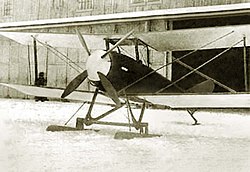Shishmarev MK-1
| Shishmarev MK-1 Rybka | |
|---|---|
 The MK-1 with ski undercarriage |
|
| Type: | Fighter plane |
| Design country: | |
| Manufacturer: |
“Red Aviator” plant in St. Petersburg |
| First flight: |
1923 |
| Number of pieces: |
1 |
The Schischmarjow MK-1 Rybka ( Russian Шишмарёв МК-1 Рыбка , German Fischlein ) is a Soviet Russian fighter aircraft that was developed in the early 1920s.
development
In 1921, the management of the Naval War Fleet of Soviet Russia issued a tender for the development of a float fighter aircraft for use at sea. In the Taganrog aircraft factory , the three designers Mikhail Schischmarjow (calculations), Nikolai Michelson (drawings) and Wiktor Korwin (construction) began working out the plans for a light biplane in the following May . Schischmarjow then went to Moscow and submitted the draft to the responsible commission, which declared it the winner and decided that the aircraft should be built in the "Red Flyer" (Krasny Lyotschik, Красный лётчик) plant in Saint Petersburg . A 200 hp engine from Hispano-Suiza was purchased abroad as a drive . In the autumn of 1923 the model named MK-1 was completed and was launched for the first time, whereby it turned out that the floats had been calculated too small, because the aircraft could not hold itself horizontally and tipped with the tail backwards. This deficiency could be remedied by using larger swimmers, but it turned out to be impossible to get the "little fish" to fly. Since interest in a water fighter plane had also decreased significantly in the meantime, Michelson decided to design a land landing gear. Since it was now winter, skids were fitted instead of the wheels. Equipped in this way, the MK-1 was able to complete its maiden flight at the end of 1923. The tests carried out until the following year were disappointing, because due to the weak drive, the model only reached a top speed of 190 km / h, which was not considered sufficient for a fighter aircraft of that time. That was ultimately the decisive factor in ending the project.
construction
The MK-1 was a single-handled, tensioned double-decker in an all-wood shell construction. As a special feature, the cladding of the fuselage consisted of pieces of plywood glued together. The placement of the radiator in the wing center section of the canopy was also remarkable . The upper and lower wings were braced and connected to the fuselage by one I-brace on each side and two I-braces on each side. The float system consisted of two stepless floats arranged in parallel . When using a land chassis, both main wheels and ski runners could be attached. At the rear of all variants there was a continuous grinding spur.
Technical specifications
| Parameter | Data |
|---|---|
| crew | 1 |
| span | 7.20 m |
| length | 6.60 m |
| height | 3.00 m with floating mechanism |
| Wing area | 21.5 m² |
| Empty mass | nb |
| Takeoff mass | nb |
| drive | a Hispano-Suiza with 200 PS (147 kW) |
| Top speed (with wheel chassis) |
190 km / h near the ground 171 km / h at an altitude of 1000 m |
| Landing speed (with wheel chassis) |
171 km / h (?) |
| Armament | two 7.62mm MG |
literature
- Vadim Schawrow: On the history of Soviet aircraft construction: experimental constructions 1923 to 1925 (1) . In: Aviator Calendar of the GDR 1976 . Military Publishing House of the GDR, Berlin 1975, p. 186 .
- Manfred Jurleit: Airplane types of the Soviet Union: MK-1 "Rybka" . In: Fliegerrevue . No. 11/1972 (237) , pp. 480 .
Web links
- МК-1 Рыбка. Retrieved August 10, 2017 (Russian, history, dates, and photos).